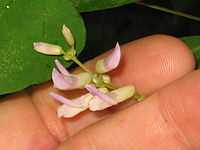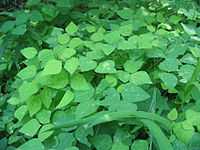BCP/Amphicarpaea bracteata
< BCP
Amphicarpaea bracteata
 Inflorescence
Wikipedia • Commons • Wikibooks (horticulture) • Wikibooks (subject) • Wikispecies • Fruit and seed clock
| Profile for Amphicarpaea bracteata (Hog-peanut)
| Identifying Characteristics |
| Habit: | Twining herbaceous forb | | Flowers: | Produces two types of flowers. The first is an unbranched, elongated inflorescence with pedicellate flowers maturing from the bottom up. These flowers open before fertilization and are usually cross-pollinated (chasmogamous). The other flowers are self-fertilized without opening (cleistogamous) and are produced on creeping branches near the ground. | | Foliage: | Trifoliate, with broadly lanceolate to ovate leaflets. | | Stem: | Smooth or covered with short hairs, coil around a support for climbing | | Growing Conditions: | Open woods, thickets | | Fruit: | The fruit is a sickle-shaped, thin-walled legume, 4-6 mm long. | | Life Cycle: | Annual | | Similar Plants: | BCP/Phaseolus polystachios | | General information: | The genus name is from the Greek and indicates that the plant has two types of fruit. Amphi meaning "both", and carpos meaning "fruit". |
Recent Logs
|
Global data:
Temperate zone season(s): Late Summer, Early Fall
Regional data and additional images for Amphicarpaea bracteata
Regional data:
New Hampshire: (native) August , September
Additional images:
 Foliage |
|
|
This page is a profile for the plant species
Amphicarpaea bracteata, used to collect records of where and when this plant was observed blooming, and for providing identification information for use in dichotomous keys. If you would like to help collect data for this or other plants, see
Bloom clock project/How to Contribute for orientation.


